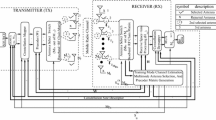Abstract
A High Data Rate (HDR) system has been proposed for providing downlink wireless packet service by using a channel-aware scheduling algorithm to transmit to users in a time-division multiplexed manner. In this paper, we propose using multiple antennas at the transmitter and/or at the receiver to improve performance of an HDR system. We consider the design tradeoffs between scheduling and multi-antenna transmission/detection strategies and investigate the average Shannon capacity throughput as a function of the number of antennas assuming ideal channel estimates and rate feedback. The highest capacities are achieved using multiple antennas at both the transmitter and receiver. For such systems, the best performance is achieved using a multi-input multi-output capacity-achieving transmission scheme such as BLAST (Bell Labs Layered Space-Time) in which the transmitted signal is coded in space and time, and the receive antennas are used to resolve the spatial interference. In the second part of the paper, we discuss practical transmitter and receiver architectures using BLAST for approaching the theoretical gains promised by the capacity analysis. Because the terminal receivers will be portable devices with limited computational and battery power, we perform a computational complexity analysis of the receiver and make high-level assessments on its feasibility. We conclude that the overall computational requirements are within the reach of current hardware technology.
Similar content being viewed by others
References
G.J. Foschini, “Layered Space-Time Architecture for Wireless Communication in a Fading Environment When Using Multi-Element Antennas,” Bell Labs Technical Journal, vol. 1,no. 2, Autumn 1996, pp. 41-59.
P. Bender, P. Black, M. Grob, R. Padovani, N. Sindhushayana, and A. Viterbi, “CDMA/HDR: A Bandwidth-Efficient High-Speed Wireless Data Service for Nomadic Users,” IEEE Communications Magazine, vol. 38,no. 7, 2000, pp. 70-77.
C.E. Shannon, “A Mathematical Theory of Communication,” Bell Systems Technical Journal, vol. 27, 1948, pp. 379-423, 623–656.
F.R. Farrokhi, A. Lozano, G.J. Foschini, and R.A. Valenzuela, The 11th IEEE International Symposium on Personal, Indoor and Mobile Radio Communications, 2000 (PIMRC 2000), vol. 1, pp. 373-377.
S. Catreux, P.F. Driessen, and L.J. Greenstein, IEEE Transactions on Communications, vol. 49,no. 8, 2001, pp. 1307-1311.
H. Huang, H. Viswanathan, and G.J. Foschini, “Multiple Antennas in Cellular CDMA Systems: Transmission, Detection, and Spectral Efficiency,” IEEE J. Selected Areas in Commun., to appear.
P. Viswanath, D. Tse, and R. Laroia, “Opportunistic Beamforming using Dumb Antennas,” IEEE Transactions on Information Theorey, submitted.
H. Huang and H. Viswanathan, “Multiple Antennas and Multiuser Detection in High Data Rate CDMA Systems,” in Proceedings of the IEEE Vehicular Technology Conference, Tokyo, Japan, May 2000.
C. Papadias, “On the Spectral Efficiency of Space-Time Spreading for Multiple Antenna CDMA Systems,” in 33rd Asilomar Conference on Signals and Systems, Asilomar Conference, Monterrey, CA, Nov. 1999.
C. Papadias, B. Hochwald, T. Marzetta, M. Buehrer, and R. Soni, “Space-Time Spreading for CDMA Systems,” in 6th Workshop on Smart Antennas in Wireless Mobile Communications, Stanford, CA, July 22–23, 1999.
I. Ghauri and D. Slock, “Linear Receivers for the DS-CDMA Downlink Exploiting Orthogonality of Spreading Sequences,” in 32nd Asilomar Conference on Signals and Systems, Monterrey, CA, Nov. 1998.
A. Jalali, R. Padovani, and R. Pankaj, “Data Throughput of CDMA-HDR: A High Efficiency High Data Rate Personal Communication Wireless System,” in Proceedings of the IEEE Vehicular Technology Conference, Tokyo, Japan, May 2000.
F. Kelly, “Charging and Rate Control for Elastic Traffic,” European Transactions on Telecommunications, vol. 8, 1997, pp. 33-37.
G.J. Foschini and M.J. Gans, “On Limits of Wireless Communication in a Fading Environment when Using Multiple Antennas,” Wireless Personal Communications, vol. 6,no. 3, March 1998, pp. 311-335.
C. Berrou, A. Glavieux, and P. Thitimajshima, “Near Shannon Limit Error-Correcting Coding and Decoding,” in Proceedings of the International Conference on Communication '93, May 1993, pp. 1064-1070.
G. Karmi, F. Ling, and R. Pankaj, “HDR Air Interface Specification (HAI),” Qualcomm Inc., Jan. 2000.
C.-L. I, C.A. Webb, H. Huang, S. ten Brink, S. Nanda, and R.D. Gitlin, “IS-95 Enhancements for Multimedia Services,” Bell Labs Technical Journal, vol. 1,no. 2, Autumn 1996, pp. 60-87.
G.J. Foschini, G.D. Golden, R.A. Valenzuela, and P.W. Wolniansky, “Simplified Processing for High Spectral Efficiency Wireless Communication Employing Multi-Element Arrays,” IEEE Jornal on Selected Areas in Communications, vol. 17,no. 11, 1999, pp. 1841-1851.
P.W. Woliansky, G.J. Foschini, G.D. Golden, and R.A. Valenzuela, “V-BLAST: An Architecture for Realizing Very High Data Rates Over the Rich-Scattering Wireless Channel,” in Proc. ISSSE, Pisa, Italy, Sept. 1998.
G. Strang, Linear Algebra and Its Applications, San Diego: Harcourt Brace Jovanovich, 1988.
B. Hassibi, “An Efficient Square-Root Algorithm for BLAST,” in Proceedings of the International Conference on Acoustics and Signal Processing (ICAASP) 2000, Istanbul, Turkey, June 2000, pp. 3129-3134.
L. Bahl, J. Cocke, F. Jelinek, and J. Raviv, “Optimal Decoding of Linear Codes for Minimizing Symbol Error Rate,” IEEE Transactions on Information Theory, vol. IT-20, March 1974, pp. 284-287.
J. Hagenauer and P. Hoeher, “A Viterbi Algorithm with Soft Decision Outputs and Its Applications,” in Proceedings of GLOBECOM '89, Nov. 1989, pp. 1680-1686.
P. Robertson, E. Villebrun, and P. Hoeher, “A Comparison of Optimal and Sub-Optimal MAP Decoding Algorithms Operating in the Log Domain,” in Proceedings of the International Conference on Communications '95, 1995, pp. 1009-1013.
Author information
Authors and Affiliations
Rights and permissions
About this article
Cite this article
Huang, H., Viswanathan, H., Blanksby, A. et al. Multiple Antenna Enhancements for a High Rate CDMA Packet Data System. The Journal of VLSI Signal Processing-Systems for Signal, Image, and Video Technology 30, 55–69 (2002). https://doi.org/10.1023/A:1014090623991
Published:
Issue Date:
DOI: https://doi.org/10.1023/A:1014090623991




